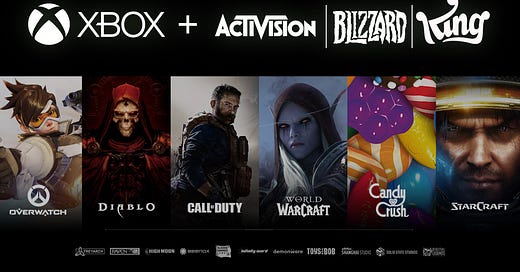Microsoft's deep gaming job cuts, and where they came from
Plus: The Pokémon Company reacts to Palworld (and to someone else)
Over the last two years, executives from Microsoft and Activision Blizzard said very little in public about the cost-cutting that might come from the combination of their companies.
Their deal finally closed last October and yesterday, just three months later, Microsoft announced internally that it was cutting some 1,900 jobs across Xbox, Bethesda and, most heavily, by all accounts, the newly acquired Activision Blizzard.
Some expected this. This is the outcome of so many mega-deals, though perhaps not always to this scale.
Two years ago, though, there was at least one hint, in the fine print.
Back in February 2022, a month after Microsoft’s $69 billion bid for the maker of Call of Duty, World of Warcraft and Candy Crush was announced, Activision Blizzard (ABK) sent stockholders a lengthy breakdown of the proposed deal, urging them, in accordance with the board’s approval, to vote for it.
On page 33, amid an explanation of how the Microsoft offer came to be, is a reference to a potential offer by another company, dubbed Company A, and the board’s disinterest in it. A hitch, the Activision Board had discussed, “among other things,” was that a deal with Company A “would not likely yield significant cost synergies.”
“Cost synergy” is, of course, often a euphemism for laying a lot of people off, usually the ones in overlapping departments. The combined companies probably won’t need as many lawyers and HR workers, as many IT professionals and spokespeople, because, in theory, such offices can be unified, then trimmed.
Cost synergies are at least some of what happened at Activision Blizzard yesterday, though no one will officially say how hard the overlapping teams got hit.
The public pitch for MS-ABK was always about other corporate upsides.
The deal would “bring the joy and community of gaming to everyone, across every device,” Microsoft said in its January 2022 announcement of its offer. And it would “accelerate the growth in Microsoft’s gaming business across mobile, PC, console and cloud.”
(In a sign of how transient the buzzwords meant to impress investors are, the opening paragraph of that deal announcement concludes with the now-archaic boast that buying Activision Blizzard “will provide building blocks for the metaverse.” Can’t wait!)
In the spring of 2022 an unexpected added benefit emerged: Microsoft buying Activision Blizzard might, in fact, be good for the companies’ workers.
That March, Bernie Sanders, Elizabeth Warren and two other U.S. Senators had pressed the Federal Trade Commission over how the mega-deal would impact Activision Blizzard workers who were already at loggerheads with the company over misconduct scandals and obstacles to their efforts to unionize. Microsoft may have felt the heat. By June, the main union backing the ABK workers, the Communication Workers of America, secured a “labor neutrality agreement” from Microsoft to ease unionization attempts at the combined company. In exchange, the CWA blessed Microsoft’s bid.
Last October, the CWA celebrated the close of the deal, declaring it “a new day for workers at Activision Blizzard.” The CWA had victories to point to, among them the neutrality pact and the formation of Microsoft’s first union in its 48-year history: about three hundred game testers at Microsoft’s ZeniMax family of studios.
Yesterday, the other shoe dropped.
In a memo to his newly expanded team that was first reported by The Verge, Microsoft gaming chief Phil Spencer said “the leadership of Microsoft Gaming and Activision Blizzard is committed to aligning on a strategy and an execution plan with a sustainable cost structure that will support the whole of our growing business.”
“Together,” he continued, “we’ve set priorities, identified areas of overlap, and ensured that we’re all aligned on the best opportunities for growth.”
The result: 1,900 people cut out of a 22,000 person gaming workforce at Microsoft.
Surely, everyone knew some cuts were coming.
Not quite.
“It took us completely by surprise,” Dan Hsu, who worked at Blizzard from 2018 until yesterday, told me over the phone last night.
Hsu was on the PC commercial team for Battle.net, Activision Blizzard’s PC gaming marketplace, primarily used to sell World of Warcraft and other beloved Blizzard titles (Call of Duty, too). Over the last two weeks, Hsu had gotten his Microsoft username, email and info about stock.
He’d thought about how some of Microsoft’s recent big purchases of game companies had gone and the lack of carnage around them. “We’d been seeing how they work with DoubleFine and Bethesda and other acquisitions,” he remembered musing with his colleagues. “It doesn't seem like Microsoft goes in and starts tearing things apart.” Citing scenes from Office Space, he said no one had come around asking who the high and low performers were.
Then yesterday happened and Hsu’s 15-person team lost five, including himself.
Hsu’s story wasn’t unique. Across social media and LinkedIn yesterday, members of the Xbox’s newly extended gaming operation said they’d been let go. Shocked developers at Activision’s Call of Duty studios including Sledgehammer and High Moon said they were hit. Community managers on Call of Duty Warzone and Bethesda’s Fallout 76 out. Overwatch team members. Workers at Activision’s tiny Toys for Bob. Blizzard chief Mike Ybarra announced his exit, too, with Microsoft promising to announce a new head of the division soon.
The depth of cuts went beyond any cost synergies.
Microsoft’s gaming leaders cut into development teams and killed at least one big project, a survival game at Blizzard—in development for six years and regarded well by some internally, per a Bloomberg report—also gone along with much of its team.
Activision Blizzard had not seemed like a company in dire financial straits. “They were not in trouble,” Doug Creutz, analyst at TD Cowen, told me. “They were still in position to take [market] share from people who are in trouble.”
Headcount had increased dramatically in recent years, from 9,800 full and part-time workers at the end of 2021 to 13,000 at the end of 2022, partially due to a dramatic expansion of the Call of Duty dev teams. But the company remained profitable, generating well over $8 billion in revenue in recent years, with strong operating margins. One catch: Analysts note signs of reduced performance for 2023. (Activision Blizzard had told investors in early 2022 that it would generate more than $10 billion in revenue in 2023; Creutz believes they delivered in the high $9b range. Wedbush’s Michael Pachter: “They were crushing it all year, till CoD got bad reviews.”)
The CWA, which backed the deal, said yesterday that the layoffs did not impact the hundreds of workers at ZeniMax, Activision and Blizzard who are represented by the union. The cuts, the CWA said in a statement to Game File, make “clear that, even when you work at a successful company in an extremely profitable industry, your livelihood is not protected without a voice on the job.”
In January 2022, I interviewed Phil Spencer about his career and the newly announced Activision Blizzard bid.
When I asked about fears of job cuts or diminished game quality that could come from a mega-merger, he replied:
“When I think about the teams that we can bring on, I need to support them and give them safety and a sense of confidence that they can go and innovate… And when they go create things, I want to enable those games to reach more people than they've ever seen before.”
I didn’t view his comments as a sign that there wouldn’t be typical merger cuts. I did sense a desire to support and retain the talents of a massive team.
Early 2022 was a different time, of course, one of gaming mega-mergers and soaring player counts, not yet the time of slow growth and rampant industry layoffs. That’s probably why the last thing Spencer said to me about the deal back then hits differently today as the industry is in upheaval. One could argue that neither of us could have seen 2024 coming, but you could easily argue the opposite.
Spencer and I were talking about what a huge team of game makers Xbox would have post-merger.
“There's a lot of responsibility for that. And I definitely feel that,” he said.
“The people who work in Xbox today [in January 2022] have an infinite number of places they could go and work. The number of people calling our people every single day to go work at other places [is high]. So I know that in order to keep people dedicated to what we're doing here, I have to create a place where people feel like they're well-compensated, they're safe, they can go do great work.
“And I don't think that changes at all once this deal is done. There's so many places that want video game talent right now. So I think it really comes down to supporting our art and respecting our teams.”
Item 2: Pokémon company talks [Palworld]
“We have received many inquiries regarding another company’s game released in January 2024,” begins a statement from The Pokémon Company published mid-week.
That’s a roundabout acknowledgment from the makers of Lucario and Eevee (not Anubis and Cremis) that people are asking them if they’re going to go after Palworld, the massively popular new survival game with Pokémon-style creatures.
The Pokémon Company says they’re looking into it: “We intend to investigate and take appropriate measures to address any acts that infringe on intellectual property rights related to the Pokémon.”
Note they’re not saying that Palworld infringes, and bear in mind that Palworld trailers, chock full of Pokémon-like creatures have been widely shared online since mid-2021. (The game, by the way, is biggest in China.)
As for things The Pokémon Company and their partners at Nintendo are definitely taking legal action against…
On January 11, Nintendo of America filed its opposition to a card company’s attempt to trademark the term PokéZoo. Close observers of PokéZoo’s November 2021 trademark submission might see why the Pokémon folks feel this one could cause some brand confusion…
Item 3: In brief
🍎 Apple will allow competing app stores and side-loaded apps on iOS in countries in the European Union, Axios reports.
Epic Games says it will re-release Fortnite for iOS in the region later this year, as a result. But they’re still not all that thrilled with Apple.
🍏 Apple has also loosened restrictions globally on game-streaming apps, paving the way for Xbox Game Pass to potentially come to iPhones and iPads via cloud-streaming, VGC reports.
🤔 Microsoft became the second company ever to achieve a $3 trillion market value on Wednesday.
⁉️ A possible gaming first: The makers of Love Live! School Idol Festival 2 Miracle Live have announced the game’s launch (Feb 2024) and shutdown (May 2024) at the same time.
Item 4: The week ahead
Friday, Jan. 26
Like a Dragon: Infinite Wealth (PC, PlayStation, Xbox) and Tekken 8 (PC, PlayStation, Xbox) are released.
Tuesday, Jan. 30
Death Stranding: Director’s Cut (iOS, Mac; already out on PC and PlayStation) is released.
Suicide Squad: Kill the Justice League (PC, PlayStation, Xbox) is released for those paying for early access. Time to discover how the legendarily long development cycle for this game panned out. SSKtJL launches for everyone else on Friday, Feb 2.)
EA and Microsoft both announce quarterly earnings.
Thursday, Feb. 1
Granblue Fantasy Re:Link (PC, PlayStation) is released.
Friday, Feb. 2
Persona 3 Reload (PC, PlayStation, Xbox) is released.
Apple’s Vision Pro AR/VR headset is released.
Item 5: More of me
I recently spoke to People Make Games’ Chris Bratt for his podcast The Games Press. Listen if you’d like to hear more about the state of the games journalism, my transition from Axios to Game File and who does or doesn’t call me Steve.







That Love Live game is a pioneer 🤣🤣🤣
I don't know if we're in the midst of a AAA studio crash but something is definitely off with the industry.